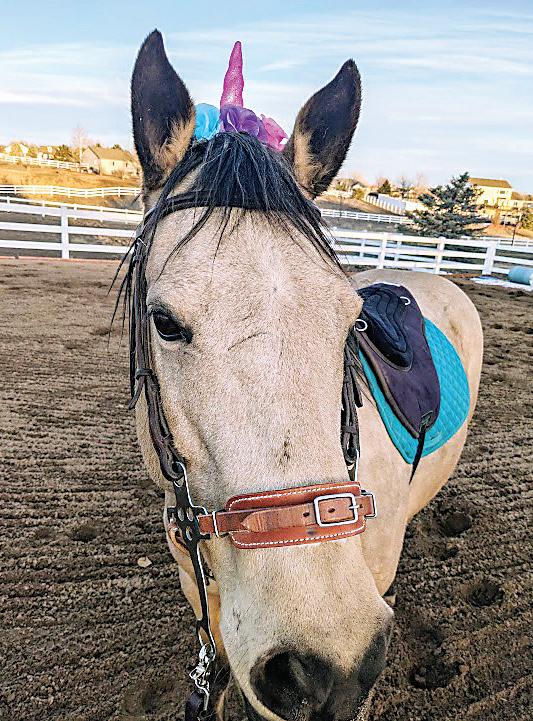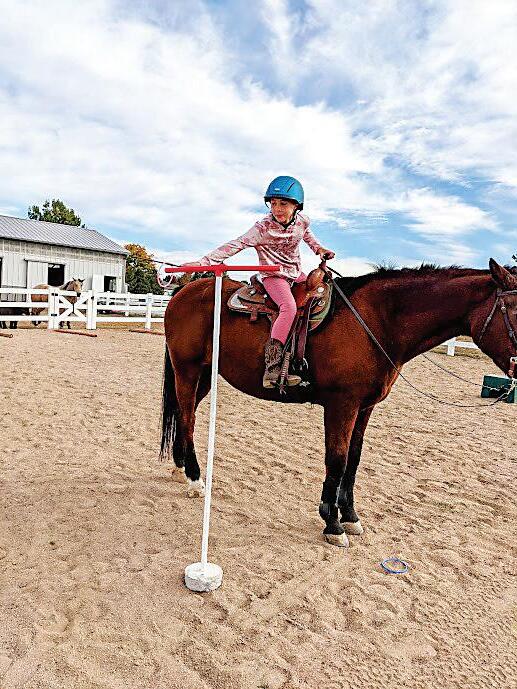
7 minute read
NORTON


With each passing hole, we dug deeper into his thoughts, and nally Brian asked me what I thought. e real question he was trying to answer was whether or not he saw this as a huge opportunity to have a signi cant impact on the business and the people or was he already planning for what happens next. At 52, the wheels in his head were spinning fast, so much more to do and so much opportunity in front of him. CEO today, chairman of the board tomorrow. Who knows what the world holds for Brian?
I asked Brian if I could share something I heard Zig Ziglar share with so many of us. Of course, he said yes. Zig, and now his son Tom, speak about the fact that we move through our careers and life in cycles. We rst have to be before we can do, and do before we can have. And once we become who we want to become, do all the things we want to do, and have all that we desire to have, we can then give more of who we are, what we do, and what we have. At that point we move from being successful to becoming signi cant, and then to leaving the legacy we want to leave. Brian remained silent as we drove on to the next tee box and even through our drives on the next hole. I could tell he was processing. As we walked back to the cart, I reminded him that I was only the messenger of that message, but I wished I was the one who thought of the concept. He laughed and then said that it was the best insight and reality check he had heard in a long time. He shared that it made him stop thinking about how
Madhavan then reached out to A Precious Child, which has a program called Precious Gift that provides families with a birthday gift and cake.
“When I saw their birthday bags, I thought it was perfect,” she said.
Josie Martinez, programs coordinator for A Precious Child, said Madhavan’s donation helped provide 200 children with a full birthday experience. Madhavan’s birthday supplies were added to the Precious Gift kits, which are distributed to families who are referred to the nonpro t for services.
“(Shriya) collecting extra goodies for those birthday bags really makes it even more of a special celebration,” Martinez said.
Martinez said the kits were given away relatively quickly because A Precious Child typically serves 32 families per day at their Resource Center in Broom eld. e nonpro t partners with over 500 agencies in Adams, Arapahoe, Boulder, Broomeld, Denver, Douglas, Je erson and Weld counties for referrals.
On the day Madhavan dropped o the birthday supplies, she also received a certi cate of thanks from A Precious Child and a tour of the high he could climb, and instead start thinking about how high he could help others climb.
Last week my column was a tribute to a friend and colleague Jill. In the past 15 years of writing this column I had never received the number of emails, texts, and comments on any previous column. And all of the messages had common themes, “I wish I would have known her,” “She must have been something really special,” “I hope people remember me that way,” or “What a legacy she left behind.”

And now I share Brian’s story above because regardless of our role in life, we all don’t have to be a CEO, we can move from being to doing to having to giving and to leaving a legacy. And it starts with a very simple concept that David H. Sandler, the founder of Sandler Training, introduced us to, the idea of focusing on our attitude, our behaviors, and our techniques, in other words building the whole person, to set us on the path to one day moving from success to signi cance and signi cance to legacy.
Is it always about what’s next and how high you can climb? Or is it about how you can help others climb higher faster, and helping them on their own journey of being, doing, giving, and leaving their legacy? I would love to hear your story at gotonorton@gmail. com, and when we can remember to strive for success so we can move to signi cance and then leave the legacy we would be proud of, it really will be a better than good life.
Michael Norton is an author, a personal and professional coach, consultant, trainer, encourager and motivator of individuals and businesses, working with organizations and associations across multiple industries services in Broom eld. Madhavan said she hopes she had a positive impact on her community.



“It was pretty exciting honestly because I felt like I could help a certain amount of people, but hopefully inspire people to help others,” she said.
Shriya Madhavan, center, donates birthday supplies, including balloons, party hats and cards, to A Precious Child, a Broomfield nonprofit that helps families in crisis.
BY TAYLER SHAW TSHAW@COLORADOCOMMUNITYMEDIA.COM
When people think of horses, they might associate them with ranch living, horse racing or recreational riding, but horses can be therapeutic, too. erapy takes many forms, from physical to mental. Some people travel to a ranch to work with horses as part of the therapeutic process.
Equine-assisted therapy was something Arvada native Kelsey Petitt discovered while studying occupational therapy at Pima Medical Institute in Denver. Having grown up riding horses, it immediately caught her attention.


“I just, kind of, was like, ‘Oh my gosh, this is the coolest thing ever. I can combine my true passion of horses and really being able to help and assist participants and patients with doing therapy and reaching their functional goals while also having fun with horses and having that relationship,’” Petitt said.
Although she knew immediately that equine-assisted therapy was something she wanted to pursue, she did not do so immediately. Following her schooling and clinical internships, she quickly began working and then had her daughter.
However, in 2021 Petitt, who now lives in Brighton, decided to establish the Brighton-based Prestige erapeutic Equestrian Center, o ering an occupational therapy program that brings the four-legged companions into the practice.
“Now, I’m going on 11 years of being a therapist and so it’s taken me a little bit of time to get back to, really, what I wanted to do,” said Petitt, who also works as an occupational therapy assistant for a company called erapeutic and Rehabilitative Associates. Her purpose, like many other therapists incorporating horses into their practice, is clear: “Transforming lives through the therapeutic power of horses.”
Bringing horses into occupational therapy
Occupational therapists help people develop skills so that they can perform day-to-day tasks such as bathing, dressing and eating, as well as techniques to aid in memory and concentration, according to the American Occupational erapy Association.
For example, occupational therapists may work on a person’s ne motor skills, such as being able to button a jacket or holding a fork, Petitt said.
ey also work on sensory integration, which she said usually comes up when working with someone who is on the autism spectrum.
Another example of work they do is helping someone with their feeding skills, such as for patients with Parkinson’s disease who experience a lot of tremors. Improving core strength may also be a focus for patients, such as for someone who struggles to put their shirt on due to a lack of strength.
“ ere’s an array of di erent settings that you can get into in the occupational therapy eld, but I think for me, the equine-assisted movement is just something that I’ve always loved,” she said. “Horses are just so therapeutic in general, for anybody.” e term “hippotherapy” refers to how occupational therapy, physical therapy and speech-language pathology professionals use equine movement as a therapy tool, according to the American Hippotherapy Association.
To use hippotherapy in treatment, a person must be a licensed therapist who has completed continuing education in the inclusion of horses and equine movement, per the association.
Petitt has gotten her rst level of training with the association, and she plans to continue with her training this fall.
However, Petitt explained that she does not refer to herself as a hippotherapist because hippotherapy is not its own therapy.
“We’re not hippotherapists,” she said. “Hippotherapy is utilizing the horse. All of our treatments are either occupational therapy, speech therapy or physical therapy, and we’re just using the horse as a treatment tool, basically.” ere are di erent planes for the horse in the way that their pelvis moves — the sagittal plane, frontal plane and transverse plane, she said.
With her clients, she said she is working on all of the same therapy interventions that she would be in a therapy gym or in an outpatient program, but instead she’s now doing it by having her clients get onto a horse and incorporating the horse’s movement into the treatment.
“We work o the horse’s pelvis, so their pelvis is very similar to ours,” she said.
“We’re working on that constantly, so when we have our riders on the horse, they’re also working on that. And it’s one of the most multi-dimensional movement(s) that’s rhythmic and repetitive,” she said.
For someone experiencing conditions such as limited mobility, limited core strength, cognitive delays, or sensory processing disorders, “it can really just kind of help bene t and improve all of those elements,” she said of equine-assisted therapy.
According to a study published in the international journal, Physiotherapy eory and Practice, there are “signicant positive e ects” of equine-assisted therapy on exercise tolerance, mobility, interpersonal interactions and quality of life of people with disabilities.
Another study focused on the ef- fects of equine-assisted activities and therapies for individuals on the autism spectrum and concluded that these programs “substantially improve” the social and behavioral functions of people who are on the autism spectrum.

“Communication is pretty key, too … because horses mirror us, so a lot of our participants can learn a lot more speech and communication successfully with the horses, which is really great,” she said.
Petitt has three horses she works with. e horse a client is paired with is dependent on their individual needs, she explained.
“Part of what’s so cool is because we can kind of tailor it to that participant, that patient, and kind of really work on what we need to work on with them,” she said. “ eir postural control, sensory systems, motor planning.”
In a typical therapy gym for occupational therapy, Petitt said there are tools such as a swing, a ball and a mat to use for the session. However, these do not provide the same level of sensory input and rhythmic, consistent movement that equine-assisted therapy can, which she said is great at building overall strength, control and balance.
“We can work in the therapy gym all day but the bene ts and the outcomes that we’re seeing while doing therapy








